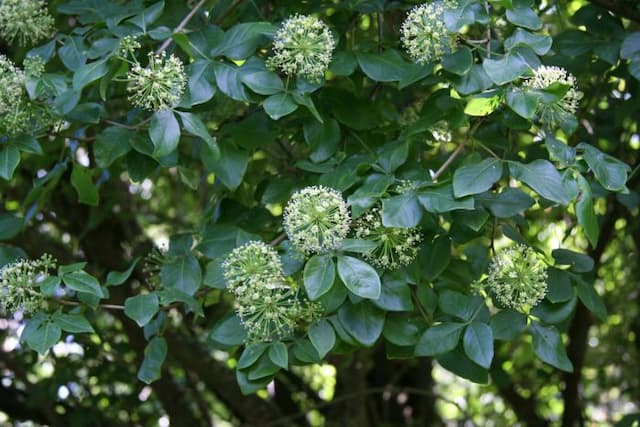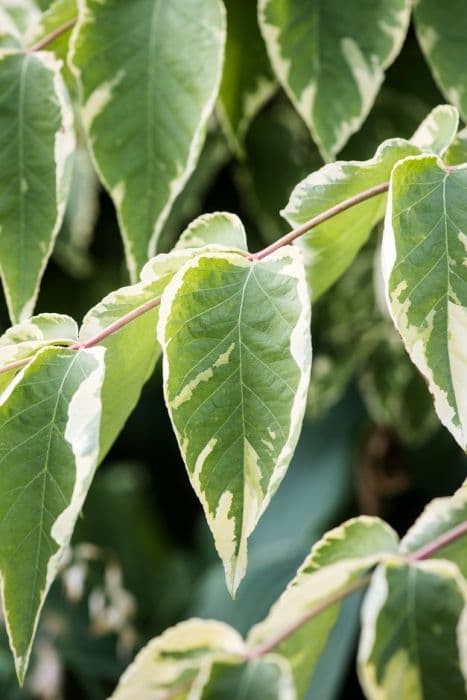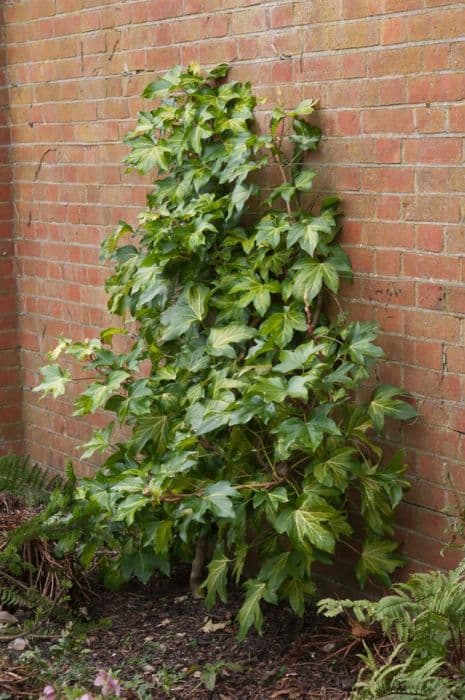English Ivy Hedera helix 'Pedata'

ABOUT
Hedera helix 'Pedata', commonly known as the English ivy, is a robust and versatile evergreen vine known for its climbing and trailing habit. This variety of English ivy is characterized by its distinctive leaves, which are deeply lobed giving them an almost hand-like shape, hence the name "Pedata." The leaves are glossy, showcasing a rich green hue with prominent, lighter-colored veins. Each leaf intricately patterns onto the vine as if carefully crafted by nature. The texture of the foliage is slightly leathery to the touch, providing a sturdy and resilient structure to the plant. Clusters of small, inconspicuous flowers may bloom under optimal conditions, typically appearing in a subtle shade of greenish-yellow. These flowers can give way to small berries that are usually not a focal point when admiring the plant's beauty. The appearance of the English ivy can vary greatly as it either climbs up surfaces or trails along the ground, forming a lush carpet of greenery. Its adaptability and ornamental charm make it a popular choice for gardening enthusiasts looking to add a touch of elegance to their green spaces.
About this plant
 Names
NamesSynonyms
English Ivy, Common Ivy, European Ivy.
Common names
Hedera helix f. pedata, Hedera pedata.
 Toxicity
ToxicityTo humans
The common name of Hedera helix 'Pedata' is English ivy. English ivy contains triterpenoid saponins and polyacetylene compounds that can be toxic to humans if ingested. Symptoms of poisoning may include gastrointestinal disturbances such as abdominal pain, vomiting, and diarrhea, as well as hypersalivation. In severe cases, ingestion can lead to respiratory issues or coma. Additionally, contact with the sap can cause dermatitis or skin irritation in sensitive individuals.
To pets
English ivy is also toxic to pets. Ingesting its leaves can cause similar symptoms as in humans, including vomiting, abdominal pain, hypersalivation, and diarrhea. In more severe cases, English ivy ingestion can result in difficulty in breathing, increased heart rate, muscle weakness, or even coma. Pets showing these signs after consuming any part of the plant should receive immediate veterinary attention.
 Characteristics
CharacteristicsLife cycle
Perennials
Foliage type
Evergreen
Color of leaves
Green
Height
50 feet (15 meters)
Spread
6 feet (1.8 meters)
Plant type
Climber
Hardiness zones
5
Native area
Europe
Benefits
 General Benefits
General Benefits- Aesthetic Appeal: Adds natural beauty and greenery to indoor and outdoor spaces with its classic ivy appearance.
- Adaptability: Thrives in a variety of environments and is tolerant to different light conditions.
- Erosion Control: When planted outdoors, it helps prevent soil erosion due to its dense growth habit.
- Wildlife Habitat: Provides shelter and food for birds and insects when grown outdoors.
- Privacy Screen: Can be grown on trellises or walls to create a natural privacy barrier.
- Low Maintenance: Requires minimal care once established, making it convenient for busy plant owners.
- Versatility in Landscaping: Used in various garden designs, from ground covers to vertical gardening on walls and fences.
 Medical Properties
Medical Properties- Hedera helix, commonly known as English ivy, has been traditionally used as a topical treatment for skin inflammation and burns due to its saponin content.
- Due to its expectorant properties, English ivy has been used in folk medicine for respiratory conditions such as bronchitis and asthma.
- The leaves have been used to make a tea that is believed to be helpful in alleviating coughs caused by colds.
- Antimicrobial properties have been attributed to English ivy, suggesting potential for treating infections.
- Components found in English ivy are being studied for their potential to provide antioxidant benefits.
 Air-purifying Qualities
Air-purifying QualitiesThis plant is not specifically known for air purifying qualities.
 Other Uses
Other Uses- As a natural dye: English ivy leaves can be used to create a range of dyes for textiles, yielding colors from yellow to gray-green depending on the mordant used.
- In aquascaping: Aquarists sometimes use English ivy in their tanks to create a terrestrial element above the waterline, where the plant can grow with its roots submerged.
- For entertainment: English ivy can be trained to grow in intricate patterns or on decorative frames to create living art installations or garden sculptures.
- As a cooling agent: The dense foliage of English ivy can help cool buildings when grown on exterior walls, potentially reducing the need for air conditioning.
- In photography: English ivy can serve as a lush backdrop or a natural framing device for photographers keen on outdoor or botanical themes.
- As a noise dampener: The thick ivy growth on walls can help to absorb sound, thereby reducing noise pollution in busy areas.
- In topiary: English ivy is often used in topiary to create shapes, figures, and designs due to its flexible and durable nature when pruned.
- As erosion control: The rooting nature of English ivy makes it effective at securing soil on slopes and preventing soil erosion.
- In rituals and ceremonies: Sometimes English ivy is used symbolically or as decoration during various cultural rituals and ceremonies due to its evergreen nature and association with fidelity.
- For educational purposes: English ivy can be used in schools and educational programs as a model to teach about climbing plant mechanisms and plant biology.
Interesting Facts
 Feng Shui
Feng ShuiThe English Ivy is not used in Feng Shui practice.
 Zodiac Sign Compitability
Zodiac Sign CompitabilityThe English Ivy is not used in astrology practice.
 Plant Symbolism
Plant Symbolism- Attachment and Affection: Commonly known as English Ivy, Hedera helix 'Pedata' is often seen as a symbol of attachment and affection due to its clinging nature and ability to grow in challenging conditions, much like the steadfastness of love.
- Friendship: The plant's evergreen quality and durability make it a representation of enduring friendship that survives the test of time.
- Fidelity: English Ivy's interwoven growth habit symbolizes fidelity and loyalty in relationships, as it tends to stick closely to the surfaces it climbs.
- Eternal life: As an evergreen plant, English Ivy can also represent eternal life or immortality, reflecting its year-round presence and longevity.
- Protection: The dense foliage of English Ivy has been traditionally thought to offer protection, leading to its use in landscapes around homes and buildings as a shield against negative forces.
 Water
WaterFor English Ivy, water thoroughly whenever the top inch of soil feels dry to the touch. This is typically about once a week, but it can vary depending on factors like temperature and humidity. Use enough water each time so that it begins to run out of the pot's drainage holes, indicating the soil is saturated. During the colder months, reduce watering as the plant's growth slows down. As a general guide, expect to water approximately one gallon for a standard indoor potted plant every 7-10 days, adjusting as necessary for the plant's environment and size.
 Light
LightEnglish Ivy prefers bright, indirect light but can adapt to low-light conditions. It should not be placed in direct sunlight, as this can scorch the leaves. A north-facing window or a spot that receives filtered light through sheer curtains would be ideal. If the light is too low, the plant may become leggy, with sparse, weak growth.
 Temperature
TemperatureEnglish Ivy thrives in temperatures between 50-70°F, but it can survive short periods in temperatures as low as 10°F and as high as 90°F. The ideal conditions for robust growth would be to keep it consistently within that range, avoiding sudden temperature drops or spikes. Ensure that the plant is not exposed to cold drafts or direct heat sources, as both can cause stress.
 Pruning
PruningPrune English Ivy to maintain its shape, encourage bushier growth, and remove any dead or damaged foliage. Pruning can be done at any time of the year, but it's best performed in the spring before new growth starts. Cut just above a leaf node to promote branching. Regular pruning every few months helps keep the plant looking tidy and may prevent it from becoming too invasive if grown outdoors.
 Cleaning
CleaningAs needed
 Soil
SoilEnglish Ivy prefers a well-draining soil mix with a pH of 5.5 to 6.5. An ideal mix would be one part peat, one part pine bark, and one part perlite or coarse sand to ensure good drainage and aeration.
 Repotting
RepottingEnglish Ivy should be repotted every two to three years, or when it becomes root-bound. Spring is the best time to repot, giving the plant time to establish before the growing season.
 Humidity & Misting
Humidity & MistingEnglish Ivy thrives at moderate to high humidity levels, ideally between 40% to 50%. It benefits from regular misting if indoor air is dry.
 Suitable locations
Suitable locationsIndoor
Place English Ivy in a spot with bright, indirect light and keep the soil moist.
Outdoor
Plant English Ivy in shaded to partially shaded areas with moist soil.
Hardiness zone
4-9 USDA
 Life cycle
Life cycleThe English Ivy 'Pedata', commonly known as Hedera helix, begins its life cycle as a seed, which germinates in spring or early summer when soil temperatures are cool and moisture is abundant. Seedlings emerge and progress into juvenile plants characterized by lobed, often heart-shaped leaves and a climbing or spreading habit, using aerial rootlets to adhere to surfaces. As the plant matures, it enters a vegetative stage where it can spread extensively across the ground or up host structures, becoming more woody and bushy. Adult foliage phase is marked by unlobed, ovate leaves, and it is during this stage that the plant may produce small, inconspicuous flowers in late summer or early fall, which are pivotal for sexual reproduction. Pollinated flowers develop into small, berry-like fruits that change from green to blue-black as they ripen, containing seeds that are dispersed by birds. Over time, the perennial ivy plant can cycle back through these stages, as new growth emerges from buds on the existing vines, continuing its life span for many years.
 Propogation
PropogationPropogation time
Spring to Summer
English Ivy, particularly the Hedera helix 'Pedata' variety, is best propagated through stem cuttings, which is the most popular method for this plant. The ideal time for propagation is during the spring or early summer when the plant is actively growing. To propagate by stem cuttings, select a healthy stem and cut a 4 to 6 inch (10 to 15 cm) section just below a leaf node, where the concentration of rooting hormones is high. Remove the leaves from the lower half of the cutting to prevent decay and place the cutting in a container with water or moist potting mix, ensuring that at least one or two nodes are submerged or in contact with the medium. In about two to three weeks, roots should begin to form, after which the new ivy plant can be transplanted into a pot with potting soil. Keeping the soil consistently moist and providing indirect light will encourage growth in the newly propagated plant.









